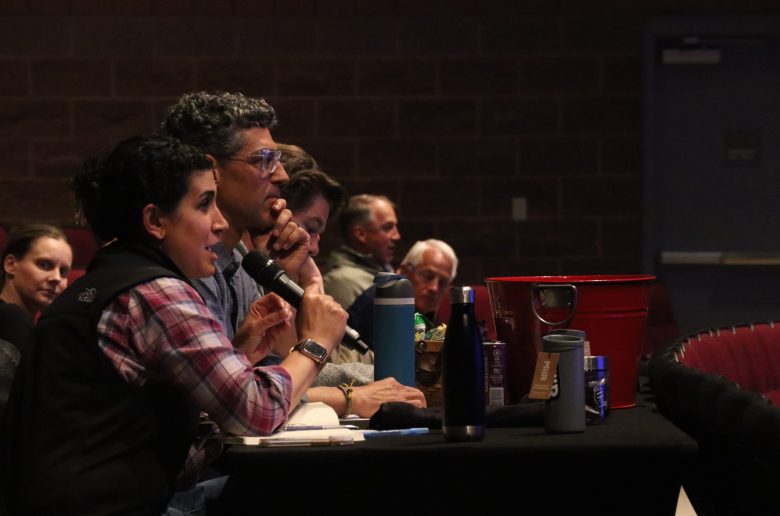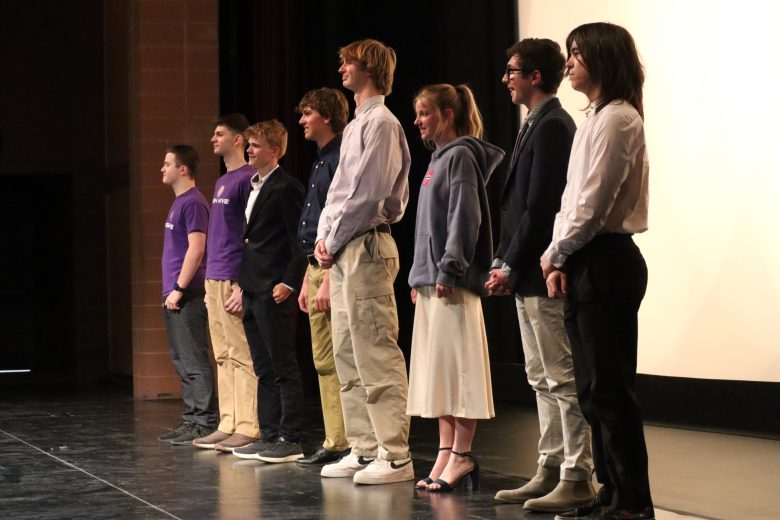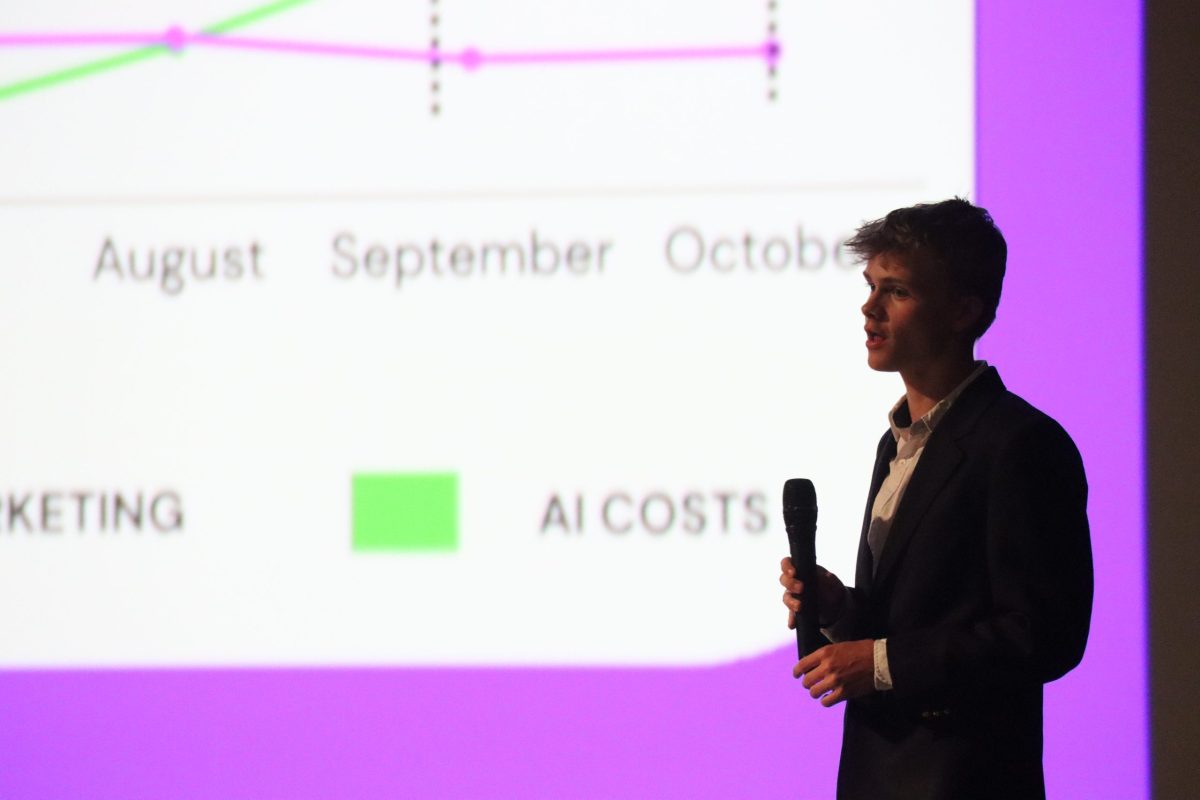Sometimes the sharks don’t bite.
Chris Drury, a Park City High School sophomore, walked away from the school’s Invest Nest competition $10,000 richer Tuesday evening after convincing a panel of judges and the audience that his idea to consolidate several generative artificial intelligence services into one subscription was an idea worth investing in.
In the statewide level of the competition on Monday at Provo High School, he’ll compete with other school districts’ winners for $20,000 more.
Before he and six schoolmates took to George S. and Dolores Doré Eccles Center Theater’s stage to pitch their ideas, they sat in the front row of the auditorium, waiting anxiously for their turn at the microphone, cue their presentation, and see if they could gain traction with the audience who would vote to determine the winner, as well as Invest Nest’s four judges — Ten Eighty Capital Chief Executive Officer Ben Rifkin, First In technology investment firm partner Lenore Karafa, Park City Mountain Chief Operating Officer Deidra Walsh, and Thomas Wadsworth, a developer who spent over nine years in the Utah governor’s office of economic development.

They had come prepared with varying investment opportunities. Renewable energy, mementos, personalized blades and opportunities within the tech industry would all be pitched to the judges and audience, and while none of the young entrepreneurs were eaten by the sharks some would find the swim more rewarding than others.
First up were Micah Anderson and Cedric Donovan, who thought they just might have the potential solution for power grids that must switch between solar and more traditional energy forms throughout the day.
“This puts a lot of stress on the grid, and we need to flatten this curve,” Anderson said.
Their solution was to create batteries that could store the solar energy through a proven chemical process that would convert it into hydrogen. They would buy the electricity at the height of the production day when they could get it cheap, then sell it back to the grid at a profit as rates go up and solar energy falls.
Though they explained their idea has garnered the attention of researchers from The University of Utah, it wasn’t enough to earn the favor of Tuesday’s investors.
The next pitch was HOME, a straightforward sweatshirt company, from junior Marcella Woolley.
“My brother recently moved to Norway, and I have always loved the Norwegian flag, so I decided that I needed to get him a hoodie with a flag on it,” she said. “All I could find were cheap, tacky souvenir-like hoodies.”
She designed and made one for him that shows the Norwegian flag, with “home” written in the country’s language, and emphasizing the boxy fit, which she said is trending now.
Woolley said she planned to start her operations slowly, that she is and will remain the sole employee for now, and that sourcing and embroidering hoodies will be outsourced to Park City company Offbeat Productions.
With a three-phase plan, however, she wants to grow the project into an established, self-sufficient brand.
“The first phase, we will reach international missionaries through retail stores that already target the missionaries. Secondly, we will reach international exchange students through the programs that organize the exchange,” she said. “Phase three, of course, is the ultimate goal of having our own brand.”
Woolley ultimately took second, walking away with $5,000.
In a blast from the quickly moving tech-industry’s past, last year’s winners and now sophomores Rudger Klug and Smitriy Siminovskiy returned with Hash Hive, a mini-game app that will use users’ phones’ unused processing power to mine cryptocurrency.
“Blockchain mining is kind of like solving math equations to verify transactions on a digital ledger,” Klug explained. “When we first started mobile blockchain mining, we tried out multiple apps but found that most of them looked like scams.”
He said the services that did pay only did so with a low enough rate to make them pointless. He said Hash Hive could make users twice as much money 10 times faster.
“One of our threats is the FTX crash in November of 2022. This influences the perception of digital currencies in a negative way with the general population,” Klug said. “We chose existing blockchain miners as our initial target market since they are already committed to mobile mining and believe in the future of cryptocurrencies.”
He said the app’s revenue will come through advertisers and listed professionals the pair have signed on as well as positions they need to fill.
Klug said that with 27,000 users, Hash Hive can anticipate $15,000 a month from ad revenue.
“Our goal is to hit one million users,” he said.
This would mean they would multiply investor’s contributions by 18 with a $300,000 investment over the next few years, he said. The app is scheduled to launch June 15.
He and Siminovskiy placed third in the competition, good for $2,500.
In his his turn, Drury explained his interest in artificial intelligence without the gusto of someone who mistakes generative programs as sentient, but with the enthusiasm of a young entrepreneur who sees potential in forming one gateway to each of the most ground-breaking softwares.
“There are 15,000 AI models in the U.S., and they all try to leverage their own platform with a special skill,” he said. “Most people rely on one model, such as OpenAI’s ChatGPT, which can be great in some cases.”
For certain tasks, however, he said different programs lack in different areas.
“For example, ChatGPT struggles at basic math and lacks an image generation, while other models, such as Anthropic’s Claude software, excel at math, and Midjourney, which dominates in image generation.”
If people want to reap all of the potential benefits of AI, Drury they might spend over $100 monthly in subscription costs. That’s where his idea comes in.
“Everything AI is an interface combining the top AI technologies into one seamless platform under one subscription,” he said. “Our software works by analyzing the user’s prompts and its intention to find the best one or two AI models to answer the question. Then it sends the prompt to the corresponding AI and offers the response to the user.”
With 1.5 billion AI users worldwide, Drury said his market consists of those who want the best and fastest responses to the queries and tasks they levy on their artificial assistants.
“Invest Nest’s $10,000 gives us a solid start to finishing prototyping and start development,” he said.
After he was announced the winner, Drury said his interest in generative AI programs sprouted when he noticed how quickly the technology was developing and capturing the public’s attention. His Everything AI idea came when he was discussing the programs with his brother, a student at the Georgia Institute of Technology, and learned he was paying around $40 a month for three AI subscriptions.
He said his experience with Invest Nest helped him develop his skills as a presenter, and he enjoyed seeing his proposal come together.
Each team that didn’t place also left the competition with $1,000 to further their ideas.


